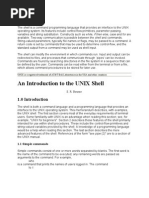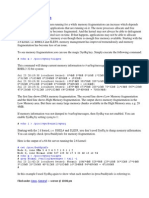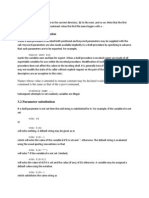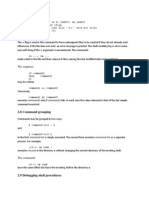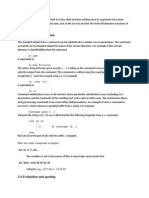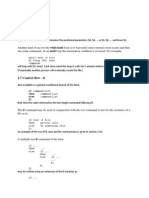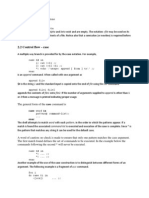3.5 Error Handling: Execution of A Command (See Also 3.7) May Fail For Any of The Following Reasons
Uploaded by
arunabhatla3.5 Error Handling: Execution of A Command (See Also 3.7) May Fail For Any of The Following Reasons
Uploaded by
arunabhatlawg=\'eval who|grep\' $wg fred
is equivalent to
who|grep fred
In this example, eval is required since there is no interpretation of metacharacters, such as |, following substitution.
3.5 Error handling
The treatment of errors detected by the shell depends on the type of error and on whether the shell is being used interactively. An interactive shell is one whose input and output are connected to a terminal (as determined by gtty (2)). A shell invoked with the -i flag is also interactive.
Execution of a command (see also 3.7) may fail for any of the following reasons.
Input - output redirection may fail. For example, if a file does not exist or cannot be created. The command itself does not exist or cannot be executed. The command terminates abnormally, for example, with a "bus error" or "memory fault". See Figure 2 below for a complete list of UNIX signals. The command terminates normally but returns a non-zero exit status.
In all of these cases the shell will go on to execute the next command. Except for the last case an error message will be printed by the shell. All remaining errors cause the shell to exit from a command procedure. An interactive shell will return to read another command from the terminal. Such errors include the following.
Syntax errors. e.g., if ... then ... done A signal such as interrupt. The shell waits for the current command, if any, to finish execution and then either exits or returns to the terminal. Failure of any of the built-in commands such as cd.
The shell flag -e causes the shell to terminate if any error is detected. 1 hangup 2 interrupt 3* quit 4*
illegal instruction 5* trace trap 6* IOT instruction 7* EMT instruction 8* floating point exception 9 kill (cannot be caught or ignored) 10* bus error 11*
You might also like
- An Introduction To The UNIX Shell: 1.1 Simple CommandsNo ratings yetAn Introduction To The UNIX Shell: 1.1 Simple Commands27 pages
- CPR E 308 Project 1: UNIX Shell: Department of Electrical and Computer Engineering Iowa State UniversityNo ratings yetCPR E 308 Project 1: UNIX Shell: Department of Electrical and Computer Engineering Iowa State University5 pages
- Introduction To UNIX: Lecture Four: 4.1 ObjectivesNo ratings yetIntroduction To UNIX: Lecture Four: 4.1 Objectives6 pages
- Bourne Shell Programming An IntroductionNo ratings yetBourne Shell Programming An Introduction30 pages
- 17CS35 Module 4 - Shell Programming Files Inode and Filters - VTUPulseNo ratings yet17CS35 Module 4 - Shell Programming Files Inode and Filters - VTUPulse23 pages
- 20 UNIX Shell Scripting Interview Questions... and Answers!!! - Part INo ratings yet20 UNIX Shell Scripting Interview Questions... and Answers!!! - Part I5 pages
- Linux Systems Administration Shell Scripting Basics Mike Jager Network Startup Resource Center Mike - Jager@synack - Co.nzNo ratings yetLinux Systems Administration Shell Scripting Basics Mike Jager Network Startup Resource Center Mike - Jager@synack - Co.nz15 pages
- Lecture-8 - Linux Session - Streams - Pipes FiltersNo ratings yetLecture-8 - Linux Session - Streams - Pipes Filters31 pages
- enc=encoded=cHHOsosmrUeVFt6xt8LBXY8zG36V_5th9tmVx4XmxgmhiZfBYIGRqw==No ratings yetenc=encoded=cHHOsosmrUeVFt6xt8LBXY8zG36V_5th9tmVx4XmxgmhiZfBYIGRqw==39 pages
- Bash, The Bourne!Again Shell: Chet Ramey Case Western Reserve University Chet@po - Cwru.eduNo ratings yetBash, The Bourne!Again Shell: Chet Ramey Case Western Reserve University Chet@po - Cwru.edu13 pages
- Unix/Linux Shell Programming: Instructor: Dr. Cheong Sio Tai, Victor Macao Polytechnic InstituteNo ratings yetUnix/Linux Shell Programming: Instructor: Dr. Cheong Sio Tai, Victor Macao Polytechnic Institute62 pages
- Lecture Notes: Shell Programming: KSH CSH SH If While ForNo ratings yetLecture Notes: Shell Programming: KSH CSH SH If While For14 pages
- Module 4 Slides UNIX Programming 18CS56No ratings yetModule 4 Slides UNIX Programming 18CS5654 pages
- BE EXPERT IN JAVA Part- 2: Learn Java programming and become expertFrom EverandBE EXPERT IN JAVA Part- 2: Learn Java programming and become expertNo ratings yet
- Acknowledgements: Item: Word Input-Output Name Value Simple-Command: Item Simple-Command Item Command: Simple-CommandNo ratings yetAcknowledgements: Item: Word Input-Output Name Value Simple-Command: Item Simple-Command Item Command: Simple-Command2 pages
- September 10, 2007: Linux Hints, Tips, and TricksNo ratings yetSeptember 10, 2007: Linux Hints, Tips, and Tricks1 page
- Apms Recruitment 2012 Roster Wise List of Candidates Allotted TGT - Zone Vi (Venue: Govt. Mahaboobia High School (Girls), Gunfoundry, Hyderbad)No ratings yetApms Recruitment 2012 Roster Wise List of Candidates Allotted TGT - Zone Vi (Venue: Govt. Mahaboobia High School (Girls), Gunfoundry, Hyderbad)12 pages
- September 2, 2007: Simple Network Performance TestNo ratings yetSeptember 2, 2007: Simple Network Performance Test1 page
- September 1, 2007: Retrieving Hardware InformationNo ratings yetSeptember 1, 2007: Retrieving Hardware Information1 page
- Case-Part: Pattern) Command-List Pattern: Word Pattern - Word Else-PartNo ratings yetCase-Part: Pattern) Command-List Pattern: Word Pattern - Word Else-Part3 pages
- 3.6 Fault Handling: Figure 3. UNIX SignalsNo ratings yet3.6 Fault Handling: Figure 3. UNIX Signals2 pages
- 3.0 Keyword Parameters: 2.10 The Man CommandNo ratings yet3.0 Keyword Parameters: 2.10 The Man Command2 pages
- 1.7 Prompting: / Is Convenient For Quoting Single Characters. When More Than One Character Needs Quoting TheNo ratings yet1.7 Prompting: / Is Convenient For Quoting Single Characters. When More Than One Character Needs Quoting The2 pages
- 1.3 Input Output Redirection: Ls - L FileNo ratings yet1.3 Input Output Redirection: Ls - L File2 pages
- An Introduction To The Unix Shell: 7 Further InformationNo ratings yetAn Introduction To The Unix Shell: 7 Further Information2 pages




